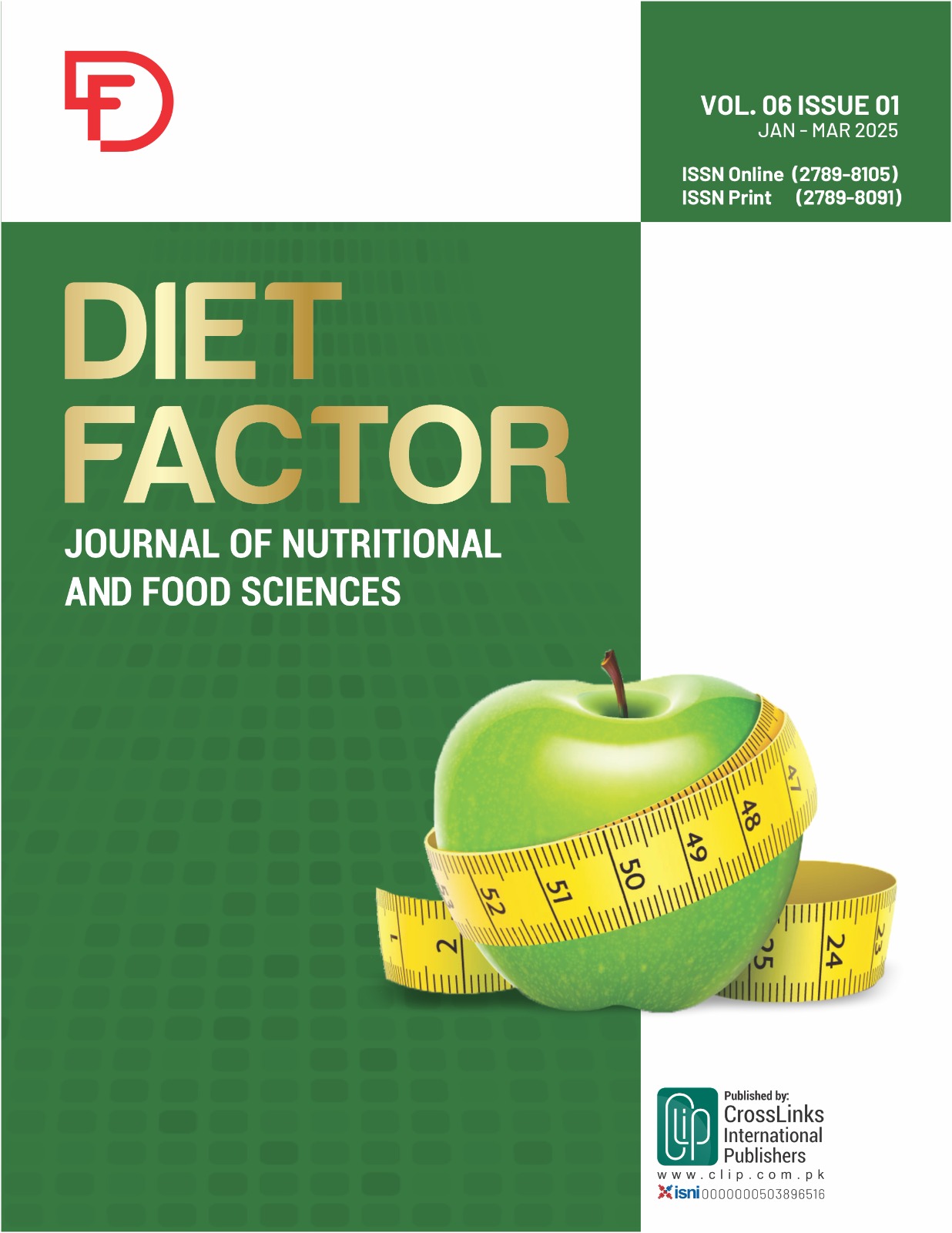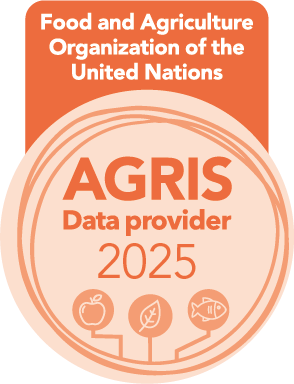Melamine a Potent Carcinogen: Detection in Packed and Unpacked Milk Samples Collected from Different Regions of Lahore, Pakistan by ELISA Method
Melamine Detection in Milk
DOI:
https://doi.org/10.54393/df.v6i1.163Keywords:
Melamine, Milk Safety, Packaged Milk, Food Contamination, Enzyme-Linked Immunosorbent AssayAbstract
Melamine is a nitrogen-rich compound often added to milk to enhance its protein contents. The European Commission has established a permissible limit of 2.5mg/kg for melamine, as excessive amounts can lead to kidney stones and other health risks for both infants and adults. Objective: To assess melamine concentrations in both packed and unpacked milk samples from various regions in Lahore, Pakistan. Methods: An experimental study was conducted using the Enzyme-Linked Immunosorbent Assay (ELISA) technique to detect melamine levels in milk samples. Measurements were obtained at a wavelength of 450 nm, following standard ELISA protocols. Results: The analysis revealed that one unpackaged milk sample contained melamine levels exceeding the permissible limit at 6.3+0.1mg/kg, while the other samples were deemed safe for consumption. Additionally, while melamine was detected in packed milk samples, all were within safe consumption levels. Conclusions: In conclusion, melamine was not found in the packaged milk samples, adhering to the acceptable limits set by the European Commission in 2009; however, one unpackaged milk sample showed a concerning level of melamine.
References
Saeed S, Rashid AA, Rizvi YA, Shehzad K, Nawaz S, Muhammad Y. Screening of melamine in Milk and Milk-based products using enzyme-linked immunosorbent assay. Nutrition and Food Sciences Research. 2021 Oct; 8(4): 29-36.
Singh P and Gandhi N. Milk preservatives and adulterants: processing, regulatory and safety issues. Food Reviews International. 2015 Jul; 31(3): 236-61. doi: 10.1080/87559129.2014.994818.
Siddiquee S, Saallah S, Bohari NA, Ringgit G, Roslan J, Naher L et al. Visual and optical absorbance detection of melamine in milk by melamine-induced aggregation of gold nanoparticles. Nanomaterials. 2021 Apr; 11(5): 1142. doi: 10.3390/nano11051142.
Barham GS, Khaskheli M, Soomro AH, Nizamani ZA. Detection and extent of extraneous water and adulteration in milk consumed at Hyderabad, Pakistan. Journal of Food and Nutrition Sciences. 2014 Apr; 2(2): 47-52. doi: 10.11648/j.jfns.20140202.15.
Abedini A, Hadian Z, Kamalabadi M, Salimi M, Koohy-Kamaly P, Basaran B et al. Melamine and cyanuric acid in milk and their quantities, analytical methods and exposure risk: A systematic review and meta-analysis. Journal of Food Protection. 2025 Feb; 88(3): 100454. doi: 10.1016/j.jfp.2025.100454.
Filazi AY, Sireli UT, Ekici H, Can HY, Karagoz A. Determination of melamine in milk and dairy products by high performance liquid chromatography. Journal of Dairy Science. 2012 Feb; 95(2): 602-8. doi: 10.3168/jds.2011-4926.
Araújo R, Moreira JL, Ratola N, Santos L, Alves A. Melamine and cyanuric acid in foodstuffs and pet food: method validation and sample screening. Analytical letters. 2012 Mar; 45(5-6): 613-24. doi: 10.1080/00032719.2011.649458.
Hu Y, Feng S, Gao F, Li-Chan EC, Grant E, Lu X. Detection of melamine in milk using molecularly imprinted polymers-surface enhanced Raman spectroscopy. Food Chemistry. 2015 Jun; 176: 123-9. doi: 10.1016/j.foodchem.2014.12.051.
World Health Organization. Toxicological and health aspects of melamine and cyanuric acid: report of a WHO expert meeting in collaboration with FAO, supported by Health Canada, Ottawa, Canada, 1-4 December 2008. InToxicological and health aspects of melamine and cyanuric acid: report of a WHO expert meeting in collaboration with FAO, supported by Health Canada, Ottawa, Canada, 1-4 December 2008 2009.
Chu CY and Wang CC. Toxicity of melamine: the public health concern. Journal of Environmental Science and Health, Part C. 2013 Jan; 31(4): 342-86. doi: 10.1080/10590501.2013.844758.
Yang L, Huo D, Jiang Y, Hou C, Zhang S. Monitoring the adulteration of milk with melamine: a visualised sensor array approach. Food Additives and Contaminants. Part A. 2013; 30(5): 786-95. doi: 10.1080/19440049.2013.793457.
Zhang M, Ping H, Cao X, Li H, Guan F, Sun C et al. Rapid determination of melamine in milk using water-soluble CdTe quantum dots as fluorescence probes. Food Add Cont. Part A. 2012 Jan; 29(3): 333-44. doi: 10.1080/19440049.2011.643459.
EFSA Panel on Contaminants in the Food Chain (CONTAM) and EFSA Panel on Food Contact Materials, Enzymes, Flavourings and Processing Aids (CEF). Scientific opinion on melamine in food and feed. EFSA Journal. 2010 Apr; 8(4): 1573. doi: 10.2903/j.efsa.2010.1573.
Hieu-Tran Q. Validation of the method for determination of melamine and investigation its trace in milk from Vietnam by LC-MS/MS. Asian Journal of Applied Chemistry. 2021 Feb; 8(1):13-9. doi: 10.9734/AJACR/2021/v8i130182.
Li W, Meng M, Lu X, Liu W, Yin W, Liu J et al. Preparation of anti-melamine antibody and development of an indirect chemiluminescent competitive ELISA for melamine detection in milk. Food Agri Immunol. 2014 Oct; 25(4): 498-509. doi: 10.1080/09540105.2013.847063.
European Commission (2009). Commission Regulation 1135/2009/EC of 25 November 2009 imposing special conditions governing the import of certain products originating in or consigned from China, and repealing Commission Decision 2008/798/EC. Off. J. L311:3. 2009 Nov; 52.
Kalambate RP, Kalambate PK, Laiwattanapaisal W. Revolutionizing melamine detection: Cutting-edge advances from traditional analyses to state-of-the-art electrochemical sensors. Next Materials. 2024 Apr; 3: 100085. doi: 10.1016/j.nxmate.2023.100085.
Chen Q, Qie M, Peng X, Chen Y, Wang Y. Immunochromatographic assay for melamine based on luminescent quantum dot beads as signaling probes. RSC Advances. 2020; 10(6): 3307-3313. doi: 10.1039/C9RA08350B
Rambla-Alegre M, Peris-Vicente J, Marco-Peiró S, Beltrán-Martinavarro B, Esteve-Romero J. Development of an analytical methodology to quantify melamine in milk using micellar liquid chromatography and validation according to EU Regulation 2002/654/EC. Talanta. 2010 May; 81(3):894-900. doi: 10.1016/j.talanta.2010.01.034.
Gouri SG. Detection of Melamine in Protein Powder. International Journal of Innovative Science and Research Technology. 2025 Apr 19; 10(4): 553-5. doi: 10.38124/IJISRT.
Joolaei Ahranjani P, Dehghan K, Esfandiari Z, Joolaei Ahranjani P. A Systematic Review of Spectroscopic Techniques for Detecting Milk Adulteration. Critical Reviews in Analytical Chemistry. 2025 Mar 10:1-32. doi: 10.1080/10408347.2025.2477535.
Downloads
Published
Issue
Section
License
Copyright (c) 2025 DIET FACTOR (Journal of Nutritional and Food Sciences)

This work is licensed under a Creative Commons Attribution 4.0 International License.
This is an open-access journal and all the published articles / items are distributed under the terms of the Creative Commons Attribution License, which permits unrestricted use, distribution, and reproduction in any medium, provided the original author and source are credited. For comments








